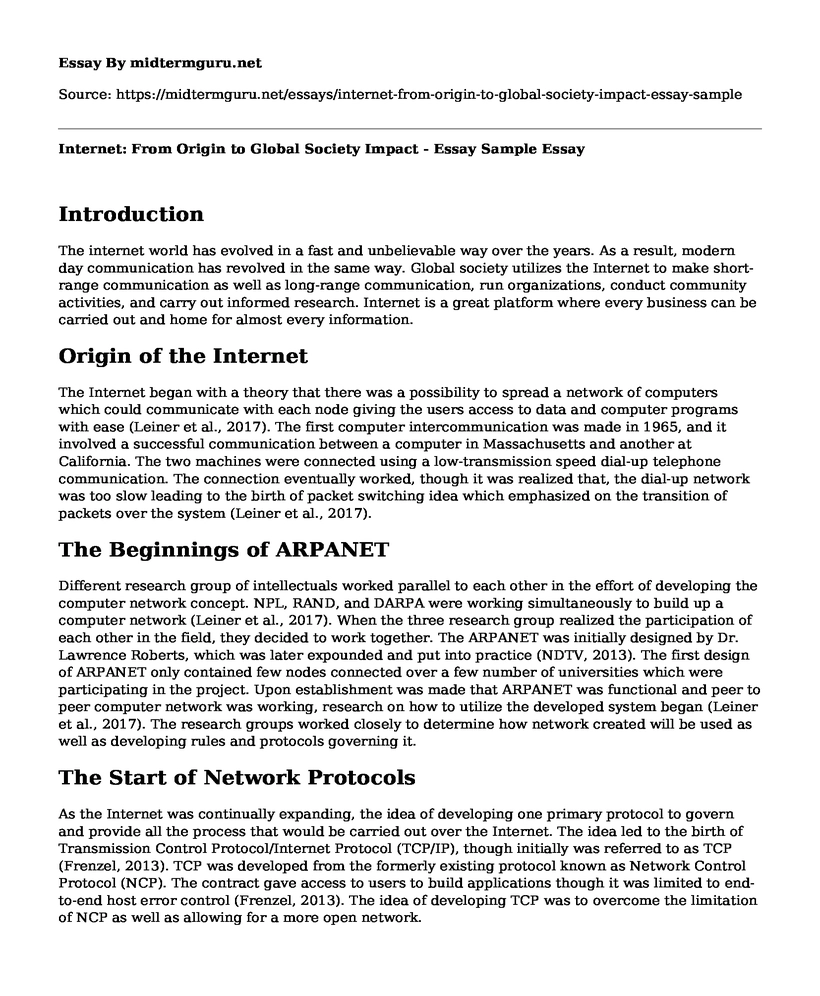Introduction
The internet world has evolved in a fast and unbelievable way over the years. As a result, modern day communication has revolved in the same way. Global society utilizes the Internet to make short-range communication as well as long-range communication, run organizations, conduct community activities, and carry out informed research. Internet is a great platform where every business can be carried out and home for almost every information.
Origin of the Internet
The Internet began with a theory that there was a possibility to spread a network of computers which could communicate with each node giving the users access to data and computer programs with ease (Leiner et al., 2017). The first computer intercommunication was made in 1965, and it involved a successful communication between a computer in Massachusetts and another at California. The two machines were connected using a low-transmission speed dial-up telephone communication. The connection eventually worked, though it was realized that, the dial-up network was too slow leading to the birth of packet switching idea which emphasized on the transition of packets over the system (Leiner et al., 2017).
The Beginnings of ARPANET
Different research group of intellectuals worked parallel to each other in the effort of developing the computer network concept. NPL, RAND, and DARPA were working simultaneously to build up a computer network (Leiner et al., 2017). When the three research group realized the participation of each other in the field, they decided to work together. The ARPANET was initially designed by Dr. Lawrence Roberts, which was later expounded and put into practice (NDTV, 2013). The first design of ARPANET only contained few nodes connected over a few number of universities which were participating in the project. Upon establishment was made that ARPANET was functional and peer to peer computer network was working, research on how to utilize the developed system began (Leiner et al., 2017). The research groups worked closely to determine how network created will be used as well as developing rules and protocols governing it.
The Start of Network Protocols
As the Internet was continually expanding, the idea of developing one primary protocol to govern and provide all the process that would be carried out over the Internet. The idea led to the birth of Transmission Control Protocol/Internet Protocol (TCP/IP), though initially was referred to as TCP (Frenzel, 2013). TCP was developed from the formerly existing protocol known as Network Control Protocol (NCP). The contract gave access to users to build applications though it was limited to end-to-end host error control (Frenzel, 2013). The idea of developing TCP was to overcome the limitation of NCP as well as allowing for a more open network.
The Evolution of TCP
Development of TCP was aimed at allowing each network to have autonomy and be able to access the system quickly. TCP ensured errors occurring in packet data transfer would be solved soon, unlike the NCP (Frenzel, 2013). The TCP allowed the data to be resent from the source to the destination node in the cases of a fault. The Transmission Control Protocol was continually updated and paired with another protocol known as Internet Protocol (Frenzel, 2013). The IP protocol provides the destination address for any packets sent from the client computer. On the other side, the TCP protocol was responsible for data recovery in the cases of loss occurrences. The combination of the two protocols became the cornerstone of the modern day protocol standards (Frenzel, 2013).
Conclusion
The world of the Internet has evolved over the years dating back to 1962. Though it started from simple peer to peer network, it is progressive evolving has resulted in more complex transmission protocols such as TCP/IP and OSI models.
References
Frenzel, L. (2013, Oct. 3). What's The Difference Between The OSI Seven-Layer Network Model And TCP/IP?. Retrieved from http://electronicdesign.com/what-s-difference-between/what-s-difference-between-osi-seven-layer-network-model-and-tcpip
Leiner, B., Cerf, V., Clark, D., Kahn, R., Kleinrock, L., Lynch, D., Postel, J., Roberts, L., Wolff, S. (2017, April 22). Brief History of The Internet. Retrieved from http://www.Internetsociety.org/Internet/what-Internet/history-Internet/brief-history-Internet
[NDTV]. (2013, Feb 03). Big interview with Vint Cerf, 'the father of Internet'. [Video File]. Retrieved from https://www.youtube.com/watch?v=RmTh2PSXA8M.
Cite this page
Internet: From Origin to Global Society Impact - Essay Sample. (2023, Jan 31). Retrieved from https://midtermguru.com/essays/internet-from-origin-to-global-society-impact-essay-sample
If you are the original author of this essay and no longer wish to have it published on the midtermguru.com website, please click below to request its removal:
- Essay on Relationship Between Sexual and Political Rebellion in 1984
- What Happened to Abigail Williams - Essay Sample
- Paper Example on Prometheus Bound
- Research Paper Example on Cybersecurity
- Questions and Answers Essay on World War 2
- Article Analysis Essay on "Frederick Douglass's Rhetorical Legacy"
- Understaffing: Is Management Ignorant of the Problem? - Essay Sample







